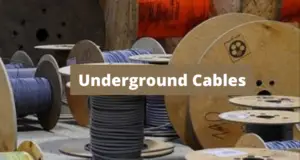Cable trays are an essential part of electrical installations in buildings, providing support and protection for various cables and wires.
However, like any other infrastructure, cable trays are prone to failures that can result in serious safety hazards, financial losses, and downtime.
In this article, we will discuss the two basic types of cable tray failures, their causes, and how to prevent them.
Table of Contents
Types of Cable Tray Failures
Cable tray failures can be broadly classified into two types: mechanical failures and electrical failures.
Mechanical Failures

Mechanical failures refer to physical damages or deformations to the cable tray that can compromise its structural integrity. Some common types of mechanical failures include:
- Corrosion: Corrosion is the most common cause of mechanical failure in cable trays. It occurs when the protective coating of the tray gets damaged or wears off, exposing the metal to moisture and other corrosive elements. Over time, corrosion can weaken the tray’s structure and lead to deformation or breakage.
- Overloading: Overloading occurs when the cable tray is carrying more weight than it was designed to handle. This can happen due to improper cable routing, poor planning, or changes in the system’s requirements. Overloading can cause the tray to bend, sag, or even collapse.
- Vibration: Vibrations can cause fatigue in the tray’s metal, leading to cracks, fractures, or weld failures. Vibrations can be caused by nearby equipment, high winds, or even foot traffic.
- Improper installation: If the cable tray is not installed correctly, it can lead to misalignment, uneven weight distribution, or inadequate support. These issues can cause the tray to fail prematurely.
Read my comprehensive article Do you really need a cable tray? here’s how to decide. for more in-depth information.
Electrical Failures
Electrical failures refer to problems with the cables or wires inside the tray that can cause short circuits, fires, or electrocution. Some common types of electrical failures include:
- Cable insulation failure: The insulation around the cables can degrade over time due to exposure to heat, moisture, or UV radiation. This can lead to shorts or grounds, which can cause electrical fires or damage to equipment.
- Cable crushing: If the cables inside the tray are not properly secured or protected, they can get crushed under the weight of other cables or objects. This can cause the insulation to wear off, leading to electrical failures.
- Cable overheating: If the cables inside the tray are carrying more current than they are designed for, they can overheat and melt the insulation. This can cause shorts, fires, or damage to equipment.
- Water ingress: If the cable tray is not properly sealed, water can enter and damage the cables and insulation. This can cause shorts, grounds, or corrosion.
Preventing Cable Tray Failures
Preventing cable tray failures requires a proactive approach that involves regular inspections, maintenance, and upgrades. Some ways to prevent cable tray failures include:
- Regular inspections: Inspect the cable tray periodically for signs of corrosion, deformation, or damage. Check the cable routing, weight distribution, and support system.
- Proper installation: Install the cable tray according to the manufacturer’s specifications and local codes. Ensure that it is properly aligned, supported, and secured.
- Upgrades: Consider upgrading the cable tray if it is not designed to handle the current load or if it has exceeded its service life.
- Protective coatings: Apply protective coatings to the cable tray to prevent corrosion and extend its service life.
- Cable management: Proper cable management can prevent overloading, vibration, and cable crushing. Use cable ties, clamps, and other accessories to organize and protect the cables.
Conclusion
Cable tray failures can have serious consequences, but they can be prevented with proper planning, installation, and maintenance.
Understanding the types of failures and their causes can help you identify potential problems and take corrective actions before they escalate.
Let’s provide a comparison table to summarize the differences between mechanical and electrical cable tray failures.
Comparison Table: Mechanical vs. Electrical Cable Tray Failures
| Failure Type | Causes | Effects |
|---|---|---|
| Mechanical Failures | Corrosion, overloading, | Deformation, breakage, bending, sagging |
| vibration, improper installation | ||
| Electrical Failures | Cable insulation failure, | Short circuits, fires, electrocution |
| cable crushing, cable overheating, | ||
| water ingress |
As we can see from the table, mechanical failures are caused by physical damages or deformations to the cable tray, while electrical failures are related to problems with the cables or wires inside the tray. Mechanical failures can result in deformation, breakage, bending, or sagging of the cable tray, while electrical failures can cause short circuits, fires, or electrocution.
To prevent mechanical failures, we need to inspect the cable tray periodically for signs of corrosion, overloading, vibration, or improper installation. We also need to install the cable tray correctly, ensure proper alignment, support, and weight distribution, and apply protective coatings to prevent corrosion.
On the other hand, to prevent electrical failures, we need to check the cable insulation regularly for signs of degradation, protect the cables from crushing or overheating, and seal the cable tray to prevent water ingress.
Don’t Leave Empty-Handed!
Install my Free Android App on Google Play:
Electrical Cables Most Common Tables “Cables Tables”
And, my Electrical Calculations App “Fast Electrical Calculator”
Discover more great content by subscribing to My channel
Looking to stay ahead of the game in the world of electrical engineering? Subscribe to my YouTube channel and gain access to exclusive content you won’t find anywhere else!
The staff I recommend
(Amazon Affiliate Links to products I believe are high quality):
- Economy 120 Volt/60Hz AC Power Source – Step-Down Voltage & Frequency Converters 1800W
- UNI-T Digital Multimeter Tester UT139C
- 50-Amp Extension Cord for RV “100ft”
- Voltage Stabilizer 110/220v
- Hair Dryer “best selling“
- TOSHIBA EM131A5C-BS Countertop Microwave Ovens
Disclaimer: This contains affiliate links to Amazon products. I may earn a commission for purchases made through these links.


